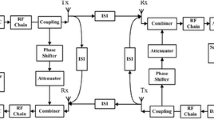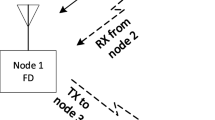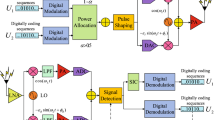Abstract
Recently, there have been hot issue and many research activities on the In-band full duplex (IBFD) for the spectral efficiency improvement in wireless and mobile communication system. In IBFD system, it is very important to cancel self-interference (SI). Especially SI cancellation of RF-stage is important because high power SI causes the saturation of ADC and the desired signal from the transmitter cannot be processed to recover the information. In this paper, we propose an RF cancellation method using the double balanced feed network (BFN) for the IBFD system, which is the main contribution of this paper. So, at first we introduce the conventional RF cancellation using BFN. Next we will show the proposed RF cancellation using double BFN. And then, we evaluate performance of the proposed circuits. As results of simulation, we can confirm that conventional RF cancellation using single BFN has 45–47 dB of SI cancellation. However, we can confirm that the proposed RF cancellation using double BFN has 72 dB of SI cancellation. This performance of SI cancellation is around 25 dB higher than conventional RF cancellation using single BFN.












Similar content being viewed by others
References
Sabharwal, A., Schniter, P., Guo, D., Bliss, D. W., Rangarajan, S., & Wichman, R. (2014). In-band full-duplex wireless: challenges and opportunities. IEEE Journal on Selected Areas in Communications, 32(9), 1637–1652.
Liu, G., Yu, R., Ji, H., Leung, V., & Li, X. (2015). In-band full-duplex relaying: A survey, research issues and challenges. IEEE Communications Surveys and Tutorials, 17(2), 500–525.
Duarte, M., & Sabharwal, A. (2010). Full-duplex wireless communications using off-the-shelf radios: Feasibility and first results. In 44th Asilomar conference on signals, systems, and computers (ASILOMAR) (pp. 1558–1562).
Radunovic, B., Gunawardena, D., Key, P., Proutiere, A., Singh, N., Balan, V., et al. (2010). Rethinking indoor wireless mesh design: Low power, low frequency, full-duplex. In Fifth IEEE workshop on wireless mesh network (pp. 1–6).
Choi, J. I., Jain, M., Srinivasan, K., Levis, P.. & Katti, S. (2010). Achieving single channel, full duplex wireless communication. In The 16th annual international conference on mobile computing and network (MobiCom).
Anderson, C. R., et al. (2004). Antenna isolation, wideband multipath propagation measurements, interference mitigation for on-frequency repeaters. In Proceedings on IEEE Southeast Conference, Greensboro, NC, USA (pp. 110–114).
Bliss, D. W., Parker, P. A., & Margetts, A. R. (2007). Simultaneous transmission and reception for improved wireless network performance. In Proceedings on IEEE statistics signal processing workshop, Madison, WI, USA (pp. 478–482).
Duarte, M., Dick, C., & Sabharwal, A. (2012). Experiment-driven characterization of full-duplex wireless systems. IEEE Transaction on Wireless Communication, 11(12), 4296–4307.
Sahai, A., Patel, G., & Sabharwal, A. (2011). Pushing the limits of full-duplex: Design and real-time implementation. Rice Univ., Houston, TX, USA, Tech. Rep. TREE1104, HYPERLINK, arXiv:1311.6247v1[cs.IT].
Duarte, M., et al. (2014). Design and characterization of a full-duplex multi-antenna system for WiFi networks. IEEE Transactions on Vehicular Technology, 63(3), 1160–1177.
Everett, E., Duarte, M., Dick, C., & Sabharwal, A. (2011). Empowering full-duplex wireless communication by exploiting directional diversity. In Proceedings of Asilomar conference on signals, systems and computer, Pacific Grove, CA, USA (pp. 2002–2006).
Everett, E., Sahai, A., & Sabharwal, A. (2014). Passive self-interference suppression for full-duplex infrastructure nodes. IEEE Transaction on Wireless Communication, 13(2), 680–694.
Bharadia, D., McMilin, E., & Katti, S. (2013). Full duplex radios. In Proceedings of ACM SIGCOMM, Hong Kong, China (pp. 375–386).
Khandani, A. K. (2013) Two-way (true full-duplex) wireless. In Proceedings of 13th Canadian workshop on information theory, Toronto, ON, Canada (pp. 33–38).
Bharadia, D,. & Katti, S. (2014). Full duplex MIMO radios. In Proceedings of 11th USENIX symposium on NSDI, Seattle, WA, USA (pp. 359–372).
Chen, S., Beach, M., & McGeehan, J. (1998). Division-free duplex for wireless applications. Electronics Letter, 34(2), 147–148.
Khojastepour, A., Sundaresan, K., Rangarajan, S., Zhang, X., & Barghi, S. (2011). The case for antenna cancellation for scalable full duplex communications. In Proceedings of ACM workshop on hot topics in network (HotNets).
Snow, T., Fulton, C., & Chappell, W. J. (2011). Transmit-receive duplexing using digital beamforming system to cancel self- interference. IEEE Transactions on Microwave Theory and Techniques, 59(12, part 2), 3494–3503.
Jain, M., Choi, J. I., Kim, T. M., Bharadia, D., Seth, S., Srinivasan, K., et al. (2011). Practical, real-time, full duplex wireless. In The 17th annual international conference on mobile computing and networking (MobiCom).
Knox, M. E. (2012). Single antenna full duplex communications using a common carrier. In Wireless and microwave technology conference (WAMICON), 2012 IEEE 13th annual (pp. 1–6, 15–17).
Acknowledgments
This research was supported by Basic Science Research Program through the National Research Foundation of Korea (NRF) funded by the Ministry of Education, Science and Technology (No. 2013R1A2A2A01005849).
Author information
Authors and Affiliations
Corresponding author
Rights and permissions
About this article
Cite this article
An, C., Ryu, HG. Double Balanced Feed Network for the Self-Interference Cancellation in Full Duplex Communication System. Wireless Pers Commun 92, 1599–1610 (2017). https://doi.org/10.1007/s11277-016-3624-y
Published:
Issue Date:
DOI: https://doi.org/10.1007/s11277-016-3624-y




